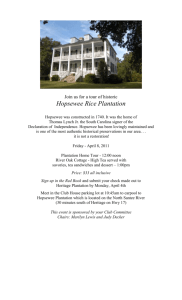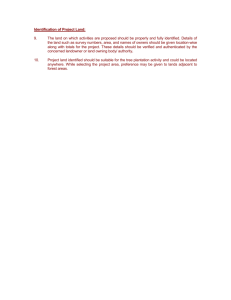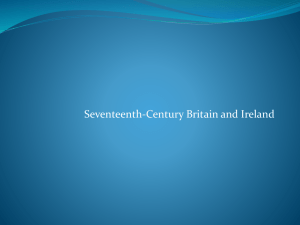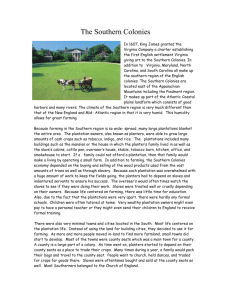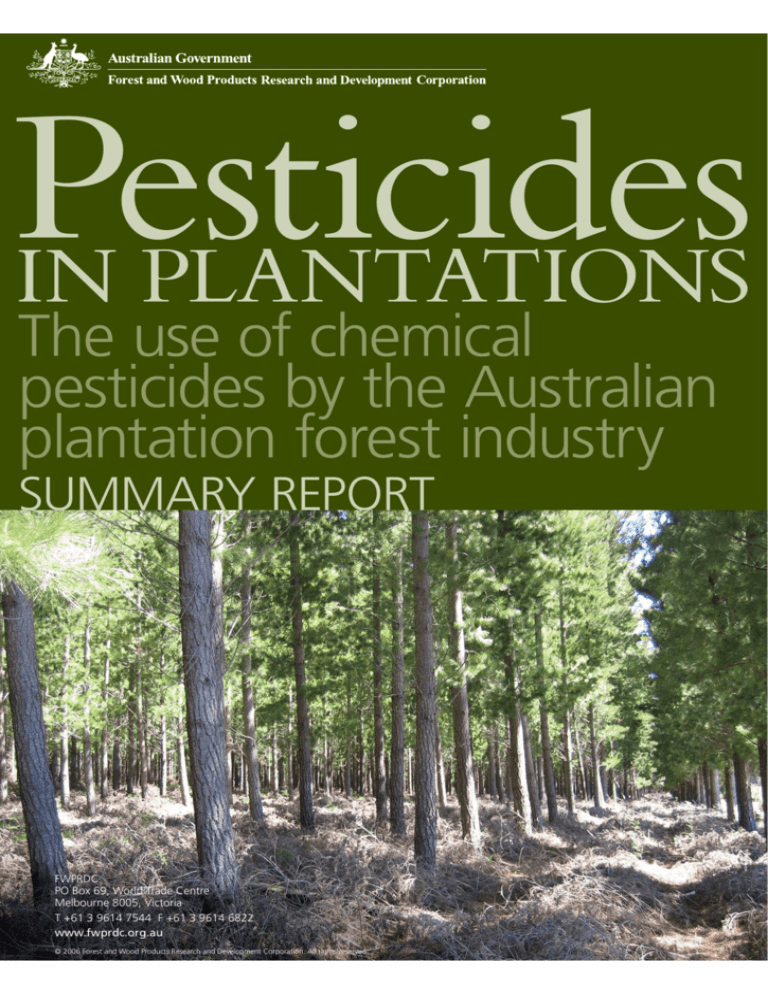
Pesticides
in plantations
The use of chemical
pesticides by the Australian
plantation forest industry
Summary report
FWPRDC
PO Box 69, World Trade Centre
Melbourne 8005, Victoria
T +61 3 9614 7544 F +61 3 9614 6822
www.fwprdc.org.au
© 2006 Forest and Wood Products Research and Development Corporation. All rights reserved.
p esticide s in pl antat ion s
CONTENTS
3 Use of chemical pesticides by the Australian plantation forest industry
4 introduction
4 pesticide definition
5Australian land use
5 Regulatory framework for chemical pesticide use
6Production/management use of chemical pesticides
8Application of chemical pesticides
9Plantation forestry compared with agricultural crops
9Application rates of chemical pesticides
10Chemical pesticide expenditure
11Sodium Fluroacetate (1080)
11 Regional usage patterns
12references
12Environmental monitoring
12Conclusion
This report summarises a major study that examined the usage of chemical pesticides by the Australian plantation forest
industry. The report was prepared for the Forest and Wood Products Research and Development Corporation by BM Jenkin of
Sylva Systems Pty Ltd and B Tomkins of GreenTree Forestry Services. Final report received September 2006.
The Forest and Wood Products Research and Development Corporation (FWPRDC) makes no warranties or assurances with
respect to this publication including merchantability, fitness for purpose or otherwise. FWPRDC and all persons associated
with it exclude all liability (including liability for negligence) in relation to any opinion, advice or information contained in this
publication or for any consequences arising from the use of such opinion, advice or information.
This work is copyright and protected under the Copyright Act 1968 (Cwth). All material except the FWPRDC logo may
be reproduced in whole or in part, provided that it is not sold or used for commercial benefit and its source (FWPRDC) is
acknowledged. Reproduction or copying for other purposes, which is strictly reserved only for the owner or licensee of
copyright under the Copyright Act, is prohibited without the prior written consent of the Forest and Wood Products Research
and Development Corporation.
Project No: PN06.4016
Researchers:
BM Jenkin
Sylva Systems Pty Ltd
PO Box 1175
Warragul Victoria 3820
Australia
B Tomkins
GreenTree Forestry Services
Creswick Victoria 3363
Australia
ISBN 978-1-920883-14-0
Photos by Braden Jenkin
Forest and Wood Products Research and Development Corporation
PO Box 69, World Trade Centre
Melbourne Victoria 8005
T +61 3 9614 7544 F +61 3 9614 6822
Email: info@fwprdc.org.au
Web: www.fwprdc.org.au
pest ic i de s in pla ntat ion s
Use of chemical pesticides
by the Australian plantation
forest industry
Key findings
n P
lantation forestry is a minor component of Australian chemical pesticide use, its estimated $16.2–20.9 million
expenditure in 2003-04, accounting for 0.7 per cent of the $2.4 billion national total;
n A
ustralian plantation forestry chemical pesticide spending is estimated to be 99.0 per cent on herbicides (including
adjuvants) and 1.0 per cent on insecticides;
n T
he chemical pesticides used by plantation forestry in Australia have been developed for other uses and have been
adapted to the needs of the plantation industry;
n A
ll chemical pesticides used by the Australian plantation forest industry are also used in food production systems by
Australian agriculture with the exception of sulfometuron methyl, which is approved for other industrial uses in Australia;
n O
f the 13 major herbicides used (based on expenditure) by the Australian plantation industry, five are also available for
purchase ‘off the shelf’ in hardware stores and/or supermarkets;
n T
he adaptation and use of chemical pesticides by the Australian plantation industry is regulated under the same
framework as all other chemical pesticide users. Because of the general use of licensed application contractors,
plantation forestry has an additional regulatory overlay for the use of chemical pesticides compared to the greater use of
unregulated operators in other industries;
n T
here are fundamental differences in the way chemical pesticides are used by the Australian plantation industry
compared to agriculture. Use in plantations is usually confined to the first two years of a plantation crop cycle (for
example a 10-year crop cycle for pulpwood or a 30-year crop cycle for softwood sawlogs); for the rest of the life of
the plantation pesticide application is very limited and generally only occurs in reaction to pest or disease outbreaks.
Agricultural crops tend to have a higher frequency of use, and in some cases, have multiple applications in each year or
for each crop;
n T
he area over which chemical pesticides may be applied within a plantation can vary from 100 per cent to about 30 per
cent of the planted area, depending on the management objective;
n I
ndustry survey results indicate most chemical pesticides are used at less than 50 per cent of the maximum label rate;
n T
he Australian plantation forest industry has developed and adapted a range of application technology to meet industry
needs;
n A
erial application of chemical pesticides by the plantation forest industry accounts for a maximum of 0.5 per cent of the
total 10 million hectares of land aerially treated with a range of chemical products each year across Australia; and
n E
nvironmental monitoring is generally conducted on a risk management basis by individual plantation managers.
Where conducted on a systematic basis, water monitoring on a whole-of-catchment basis in Tasmania has shown few
detections of chemical pesticides from any source.
p esticide s in pl antat ion s
Introduction
The use of chemical pesticides by the Australian plantation forest industry is sometimes a contentious issue.
Chemical pesticide use is a function of crop, regulatory and pest issues. To extend the understanding of the use of chemical
pesticides in the plantation forest industry, this study reviewed and assessed the:
n R
egulatory controls at Federal, State and Local Government levels;
n E
volution of, and change in, chemical pesticide use by Australian agriculture and in plantations;
n U
se of chemical pesticides in plantation and agricultural crops industry; and
n T
ypical use regimes in plantation forestry.
The study utilised published information on a range of issues relating to chemical pesticide use and attributes,
included contact with industry experts and a confidential industry survey. This survey collected responses from plantation
forestry managers responsible for the management of more than 92 per cent of the Australian plantation forestry estate.
The information collected provides details of the type, rates of application and scale of use across a range of species and
sites. The survey information provided a profile of the active ingredients and rates used by the industry. It was also the
basis of the development of comprehensive chemical pesticide use models for six zones across Australia.
Pesticide definition
In the context of plantation forestry, the definition of a pesticide used in this study was:
Any chemical or chemical mixture used for controlling weeds,
insects, fungi, nematodes and animals, which adversely affect growth
(quantity and quality) and the health of plantations.
Pesticides are usually subdivided into groups depending on target organisms, or by their action on living organisms.
The main subdivisions are herbicides; insecticides (including miticides, nematicides, molluscicides); fungicides; rodenticides;
plant regulators; defoliants; desiccants and anti-transpirants; other types of poisons and repellents; adjuvants (all additives
to chemical pesticides mixtures); and animal health products.
pest ic i de s in pla ntat ion s
Cereals
for grain
11.9%
Plantations 1.0%
Other
agricultural
land uses
Dairy cattle 1.5%
30.2%
Meat
Cattle
42.1%
Sheep
and lambs
13.3%
Figure 1 Australia’s land use over the 168
million hectares of non-rangeland
land use based on ABS (2006) for
2003-04 and Parsons et al. (2006).
Australian land use
The total area of Australia is 7,692,024 square kilometres or 769 million hectares (Geosciences Australia, 2006).
The ABS reports on an area of 440,109,578 hectares, and has captured land use data for 437,107,239 hectares for
2003-04 (ABS, 2006). It is estimated, based on ABS specific statistics (for non-livestock enterprises) and by applying stocking
rates to ABS livestock numbers, together with the National Forest Inventory data (Parsons et al. 2006) that 168 million
hectares is used for more intensive land management than occurs in the rangeland estate (Figure 1). Plantations with an
area of 1,716,173 hectares represent 1.0 per cent of the intensive land use.
Regulatory framework for
chemical pesticide use
Chemical pesticide use in Australia is regulated by the Australian Pesticide and Veterinary Medicines Authority (APVMA)
and State agencies. The APVMA is responsible for agricultural and veterinary chemicals and there are three other bodies
responsible for regulating industrial chemicals (eg. dyes and solvents), medicines and medical products (eg. for human use)
and food additives, contaminants and natural toxins (eg. food colouring).
The process applied by the APVMA is consistent across all uses and users of chemical pesticides. Registration of an
active ingredient involves three years of field testing and analysis for a new active ingredient and two years of testing to
register a new use of an existing active ingredient.
In the case of the active ingredients used by the Australian plantation forest industry, only one – sulfometuron methyl
– was not developed for agricultural use. With the exception stated, all other active ingredients used by the plantation
forestry industry are employed by agriculture for food production. Of the 13 most used active ingredients by the plantation
forestry industry (based on purchasing expenditure), five are available for unrestricted purchase from hardware stores
and supermarkets. Table 1 indicates the agricultural uses of the major chemical pesticides used by the plantation forestry
industry.
The maximum industry rate shown is based on the reported rates of use from the industry survey.
A key reason the plantation forestry industry adapts chemical pesticides developed for other uses is because its usage
does not warrant the significant costs associated with developing and registering its own specific active ingredients.
p esticide s in pl antat ion s
Production/management use
of chemical pesticides
Use of chemical pesticides is necessary for cost-effective production in plantation forestry. Weeds in a plantation may
compete for water, nutrients and space. Pest insects and browsing animals may defoliate or destroy the entire commercial
value of a tree.
Much of the research on weed control has focused on the impact on survival of the planted trees and, where the
trees do survive, the change in growth rates due to competition and physical damage. For example, effective weed
control has been shown to improve growth rates by 120 per cent over an untreated control as assessed by volume in a
softwood plantation. In the case of 66 per cent insect defoliation in eucalypt seedlings, a loss of growth resulted where the
defoliation occurred multiple times in the one season.
The plantation forestry industry has undertaken significant applied research on how to use active ingredients developed
for other uses. This has been successful in addressing a number of objectives including:
n I
mproved efficiency in the control of target species;
n R
educed environmental impacts on non-target species and water bodies;
n I
mproved environmental impacts on non-target species and water bodies;
n R
educed costs.
Developments have included the adaptation of application technology and the creation of new technology. Delivery
systems, such as dry granule application, were introduced utilising proprietary active ingredient mixes to be applied over the
top of the planted trees. The granules activate once they become moist and the active ingredient contained within begins
to leach out. Plantation forestry specific systems have been developed to address issues such as culling non-crop trees
within plantations, such as silver wattle in a radiata pine plantation.
pest ic i de s in pla ntat ion s
Table 1 Twelve chemical pesticide active ingredients used in plantation forestry and other uses of
the same chemicals. The rates shown are based on the labels of products that contain the
active ingredient. The industry maximum rate is from the industry survey.
Application rate
Active ingredient (a.i.) Current active ingredient use
Label (a.i. g/ha) Industry maximum (a.i. g/ha)
AmitroleEucalypt plantations
250-1,500
Radiata pine (silver wattle control) plantations
1,400-2,000
Water couch: in drains, channels, margins of streams, lakes & dams
990
Pre-planting rye grass & wild oats control in wheat & barley
1,232
Pre-harvest preparation for potatoes.
2,750
Vineyards and orchards
4,000
AtrazineEucalypt plantations
4,500-8,000
Radiata pine plantations
4,500-8,000
Canola
2,000
Sorghum, maize, sweetcorn, sugar cane and roadsides
2,970
Clopyralid
Radiata pine (silver wattle control) plantations
2,550
Eucalypts plantations
150-180
Barley, oats, triticale & wheat in combination with MCPA amine
150
Pastures and fallow land
600-1,200
FluroxypyrSugar cane for specific weed control
300
Woody weeds in all non-crop areas and rights of way
600
Woody weeds in forests
600
Softwood plantations
159-848
Hops, citrus and a range of orchard species
424-848
GlyphosatePlantation forestry
360-2,160
Broadacre control of a range of grasses and bracken fern
3,240
Pasture manipulation
495 - 2,160
Sugar cane – control of ratoons
2,160-3,240
HaloxyfopPlantation forestry
208-416
Couch and rhodes grass control
208-416
Control of a wide range of grasses in agriculture, horticulture, etc.
104-416
Vineyards, various orchards
208-416
Hexazinone
Radiata pine plantations
1,500-3,750
Commercial and industrial areas
3,000-6,000
The combination with diuron is used in sugar cane
1,872
MetosulamPlantation forestry
3.6-7.0
Wild radish control in lupins
3.6-7.0
Metsulfuron methylPlantation forestry on ex-pastures
Up to 9
Established pastures: control of Paterson’s Curse
9
Common bracken
36
Wheat, barley, triticale and cereal rye: a range of weeds
3 to 4
For woody weeds on second rotation plantation sites
60
Blackberry control on native pastures, rights of way, industrial areas
96
SimazinePlantation forestry
1,440-6,030
Pome fruit, apples and pears
3,600
Summer rainfall areas, non-crop residual control of grasses / broadleaved weeds
43,200
Sulfometuron methylProprietary mixture, lower rates otherwise
52.5
Grass / broadleaved weed control for wide range of industrial purposes
150-600
TriclopyrIn sorghum: control of prickly paddy melon
48
Fallow cropping land: control of prickly paddy melon
96
Blackberry control over broad areas
2,880
1,600
5,600
2,000
500
3,200
330
3,800
7
60
6,000
60
2,880
Skidder
Manual
granules
Manual
backpacks
4WD ute
Helicopter
Helicopter
Fixed wing
100 L/ha
100 L/ha
100 L/ha
50 L/ha
50 L/ha
100 L/ha
N/A
Production rate
280
260
240
220
200
180
160
140
120
100
80
60
40
20
0
Costs ($/hr)
110
100
90
80
70
60
50
40
30
20
10
0
Fixed wing
Production rates (ha/hr)
p esticide s in pl antat ion s
N/A
Application costs
Figure 2 Generic production rates for the application methods
shown and the costs of each method (with +/- 10 per cent
deviation shown). In general, the slower the process, the
higher the cost per hectare treated.
Application of
chemical pesticides
Plantation forestry varies in scale and intent across Australia, and, with that variation in estate size, the realistic options
to manage or react to issues will vary. In the case of small estates, it may be possible to conduct manual/non-chemical
pesticide forestry (such as hand-weeding or tree guards to stop browsing animals). In a large-scale industrial plantation
mechanical application of chemical pesticides is required. Further, the production rates (area treated per hour) of aerial
application methods allow rapid response to pest insect outbreaks or the ability to apply herbicides during limited fine
weather. Once the trees are planted, access restriction, due to the ‘crop height’, makes aerial application an invaluable tool.
A total of 10 million hectares of crops and pastures per year are treated by aerial application of chemical products across
Australia, and of that area, less than 0.5 per cent is plantation forest.
Figure 2 demonstrates the impact of time constraints. For example, if a plantation manager must spray 1,000 hectares
at 100 L/ha, using any of the methods shown in Figure 2, it would take 17 hours by fixed wing, 39 hours by helicopter, 400
hours with a 4WD utility vehicle or 800 hours by skidder. With a two-week window of opportunity (maximum spray time of
14 days by 6 hours per day equals a total of 84 hours) it would require one fixed wing or helicopter operation, or at least
five utility vehicles or 10 skidders. The actual choice of application method depends on the nature of the operation.
The usual chemical pesticide regime for forest plantations is to apply herbicides in the first two years and insecticides or
fungicides in response to pest outbreaks. The active ingredients used are a function of the target pest, the crop tree species
and the climate. A range of regimes may be used. Weed control usually takes place pre-plant as an initial site clean-up to
remove difficult-to-kill species prior to planting the crop trees. This is usually applied (broadcast) across the whole plantation
area. After site cultivation, the planting lines may be strip sprayed (eg. treating 50 per cent of the net planted area) or the
site broadcast sprayed.
Once planted, and depending on weed growth, follow-up weed control may be required in the same planting season
or later in the following year. The active ingredient and rates used will be a function of the active ingredient and rates of
the previous treatment. That is, if a site is initially well treated, there may be reduced requirement to undertake additional
applications of chemicals.
pest ic i de s in pla ntat ion s
25
1800
1600
Frequency (%/cases)
20
1400
1200
1000
800
600
400
15
10
Eucalypts
Figure 3 T
otal annual expenditure on chemical
pesticide inputs for three crops
increasing as the area expands up to a
total estate of 1,000 hectares.
Use rates (kg a.i./ha)
8.0
7.2
6.4
5.6
4.8
4.0
3.2
2.4
1.6
0.8
2024
2022
2020
2018
2016
2014
2012
Onions
0
>8.0
Bananas
2010
2008
0
Maximum
label rate
for plantation
forestry
5
200
2006
Estate chemical spend ($000’s/yr)
2000
Figure 4 Plantation forest industry usage
rates for atrazine. Industry reporting
indicates most use is less than 50 per
cent of the maximum label rate.
Plantation forestry compared
with agricultural crops
The plantation forestry approach contrasts with the annual use of chemical pesticides in many agricultural crops.
Specific analyses were undertaken to compare the chemical pesticide inputs to manage a Tasmanian blue gum plantation
with a banana plantation and a vegetable-growing (onion) enterprise.
In the case of the Tasmanian blue gum plantation, weed control occurs in the first two years and then does not occur
again until the crop is harvested and a new crop planted in the 11th year after the initial plantation development. In
the scenario analysed, the plantation required insecticide application at age three years. This compares with the banana
plantation with annual repeated applications of herbicides, insecticides and fungicides over the seven years of the crop,
or an annual onion enterprise with multiple applications of herbicides, insecticides and fungicides. If an estate of the three
crops were developed by planting 100 hectares per year for 10 years (up to a total estate of 1,000 hectares), the total
chemical pesticide input for the three crops would be as follows (as indicated in Figure 3):
n T
asmanian blue gum plantation: $10,918/yr (or $10.92/ha/yr);
n O
nions: $933,340/yr (or $933.34/ha/yr);
n B
anana plantation: $1,979,081/yr (or $1,911.08 /ha/yr).
Application rates of
chemical pesticides
The legal rate of application of chemical pesticides is stipulated on the product label. The label rates are the maximum rates
allowed. In practice, the plantation forestry industry has developed regimes that may utilise the active ingredient up to that
maximum rate, but the financial imperative to reduce the cost of inputs means that often the application is at less than the
allowed maximum.
The results of the industry survey indicated that for all active ingredients in use (except simazine), the actual application
rate was at less than 50 per cent of the allowed maximum in more than 50 per cent of applications considered. In the case
of simazine, more than 50 per cent of the applications considered were at less than 70 per cent of the maximum allowed.
Figure 4 summarises application rate data for atrazine reported in the industry survey. For atrazine, the maximum
allowed application rate is 8.0 kg active ingredient/ha, and the frequency distribution classes are given in units of 0.8 kg
active ingredient/ha. Any use greater than 8.0 kg active ingredient/ha (> 8.0) is in excess of the label maximum rate. The
data shown are not weighted for area, as they represent the industry survey rates reported for 2003 to 2005.
The true measure of chemical pesticide use is the rate per hectare combined with the total hectares treated. For
atrazine, the maximum allowed rate for plantation forestry is 8 kg active ingredient/ha and the industry survey showed a
maximum use rate of 5.6 kg active ingredient/ha. For canola cropping in Western Australia (WA), atrazine may be applied
twice per crop at 1.0 kg active ingredient/ha. For 2005, the industry survey showed that the WA plantation industry used
7,444 kg active ingredient of atrazine. The WA canola industry for 2003-04 grew 318,000 hectares of canola, and if
standard regimes were applied this would have resulted in the use of an estimated 636,000 kg active ingredient of atrazine,
or more than 80 times the amount used by the plantation forestry industry in WA the same year.
10
p esticide s in pl antat ion s
Plantation forestry 0.7%
APVMA total market
(excluding plantation forestry) 99.3%
Figure 5 Estimate of the overall chemical
pesticide market attributable to
plantation forestry.
Chemical pesticide expenditure
The APVMA maintains and reports on the total chemical pesticide market in Australia. For 2004, the total spend on
chemical pesticides was $2.45 billion (APVMA, 2005a: Table 2). This total includes uses such as domestic insecticides
($105.4 million).
Table 2 Australian 2004 pesticide market based on APVMA (2005).
Broad classifications
Herbicides1
Fungicides/PGR1,2
Insecticides1
Animal health1
Additives3
Domestic / recreation
Industrial
Vertebrate poisons4
Others
Totals
($/yr)
$996,719,444
$170,106,518
$374,193,750
$607,747,775
$44,801,098
$159,200,377
$77,089,086
$15,325,621
$6,037,204
$2,451,220,873
Note:
1. The allocation of nematicides, molluscicides and miticides to ‘insecticides’ is not strictly correct, but has been done so to match
the ABARE applied classifications.
2. PGR: plant growth regulators.
3. Additives include surfactants and adjuvants.
4. Vertebrate poisons include sodium fluroacetate (1080) and pindone.
Chemical pesticide expenditure information was estimated for
the plantation forestry sector by:
n D
ata from the industry survey: total expenditure for 2005 was estimated to be $16.2 million after pro rata adjustment to
100 per cent of the estate; and
n A
simple model of plantation forestry expenditure to estimate the maximum (based on maximum product label rates
and/or industry best practice): total expenditure estimated for 2005 that gave an estimated expenditure of $20.9 million.
Therefore, the total expenditure on chemical pesticides in plantation forestry is estimated at $16.2–20.9 million per
annum, or 0.7 per cent of the total Australian expenditure on chemical pesticides (Figure 5). Expenditure on chemical
pesticides in plantation forestry is less than 16–19 per cent of that spent on household insecticides. If the estimated
expenditure on household herbicides is also included (a total household spend of $175 million on herbicides and
insecticides), expenditure by plantation forestry is 9–11 per cent of Australian household/domestic spending.
Figure 6 shows a breakdown of the estimated chemical pesticide expenditure by main chemical type and plantation
management regime. The plantation forestry industry use is 99 per cent on herbicides and 1 per cent on insecticides.
Insecticides
Softwood
long rotation
Hardwood
short rotation
9000
8000
7000
6000
5000
4000
3000
2000
1000
0
Hardwood
long rotation
Annual spend ($000’s/yr)
pest ic i de s in pla ntat ion s
Herbicides
Figure 6 Estimated plantation forestry expenditure on chemical pesticides for
short rotation hardwood (pulpwood crops), long rotation hardwoods
(sawlog crops) and long rotation softwoods (sawlog crops).
Sodium Fluroacetate (1080)
Two hundred kilograms of sodium fluroacetate (1080), was used across Australia in 2003-04 (APVMA 2005b). The industry
survey indicated that the plantation forestry sector used 5.5 kg in 2005 to kill declared pest animals, such as rabbits and
native browsing animals that damage plantation trees. An additional 8.8 kg of 1080 was used to kill foxes and pigs to
comply with pest animal legal requirements and to effect good land management.
Regional usage patterns
Regional profiles of chemical pesticide use were developed for six regions of Australia. Regions were defined based on
combined National Forest Inventory (NFI) zones and the Statistical Divisions (SD) used by the Australian Bureau of Statistics
(ABS) to report on farming practices. Figure 7 shows the combined zones used in the study. Where National Forest Inventory
plantations were shown in an ABS SD, all the SD were included in that zone.
The regional profiles were developed based on generic chemical pesticide input regimes to manage the main crops
produced in each region. The generic profiles were sourced from gross margin analysis reports published by various
government agencies and other agricultural data. The areas of the non-plantation forestry enterprises were sourced
from the ABS (2006). The combined data allowed the development of chemical input profiles on a per hectare managed
basis and for each crop in each zone. Plantation forestry regimes were developed based on the industry survey, industry
knowledge and specific discussions with a range of individuals. These profiles provide an understanding of the use of
chemical pesticides in plantation forestry in each region and allow comparison with applications for typical agricultural land
use in those regions. The six data sets were aggregated to give an overall estimate for Australia.
Zone F
15
Darwin
14
Zone E
13
Zone D
Zone A
Perth
1
Zone B
4
Brisbane
11
12 Sydney
10
9
Adelaide
Canberra
8
6
7
3 5
Melbourne
Zone C
2
Hobart
Figure 7 A summary of the National Forest Inventory and Australian Bureau of
Statistics combined zones used for chemical pesticide market analysis
and reporting. (Based on Wood et al. 2001).
11
12
p est icide s in pl antat ion s
References
Australian Bureau of Statistics (2006) Purchased statistics: 2003-04 Farm Census results.
Australian Pesticides and Veterinary Medicines Authority (2005a). Agricultural chemical product sales for the calendar year 2004. Commonwealth of
Australia Gazette No. 12, 6 December, 2005.
Australian Pesticides and Veterinary Medicines Authority (2005b). The reconsideration of registration of products containing sodium fluroacetate (1080) and
their associated labels. Vol. 2: Preliminary review findings – technical report: Environmental Assessment. APVMA, Canberra, Australia. Downloaded from
www.apvma.gov.au
Department of Primary Industries and Water, Tasmania (2006). Monitoring water quality: pesticides in water catchments. Downloaded from www.dpiw.tas.
gov.au on 25 August 2006.
Geosciences Australia (2006). Area of Australia, States, and Territories. Downloaded from www.ga.gov.au on 14 September 2006.
Parsons, M., Gavran, M. and Davidson, J. (2006). Australia’s plantations 2006. National Forest Inventory, Bureau of Rural Sciences, Canberra.
Wood, M.S., Stephens, N.C., Allison, B.K., and Howell, C.I. (2001). Plantations of Australia – a report from the National Plantation Inventory and the National
Farm Forest Inventory. National Forest Inventory, Bureau of Rural Sciences, Canberra.
Environmental monitoring
Environmental monitoring of chemical pesticides mainly occurs on an ‘as needed’ basis or in response to perceived risk
of off-site movement. Individual plantation forestry managers may conduct water sampling associated with operations
and report these as part of compliance with code of practice or other regulatory requirements including sustainable forest
management reporting to comply with certification schemes.
The only systematic programme of water sampling relevant to plantation forestry is the Tasmanian Department of
Primary Industries and Water (DPIW, 2006) set of 54 water monitoring sites across Tasmania, where water samples are
collected to test for 19 active ingredients. Samples are taken on a quarterly basis and up to seven rounds have been
concluded. The sample sites cover all land uses in the catchments tested. Sampling commenced in January 2005 with no
detections – but there have subsequently been four detections generally below guideline values and all below health values.
A similar initiative in the cotton-growing areas of Queensland showed a 100 per cent rate for the detection of atrazine
for 2000-01 (13 samples). Time series data for cotton production areas of the Macintyre, Gwydir, Namoi and Macquarie
valleys showed a decline in the detection rate for atrazine from 46 per cent of samples in 1991-92 (296 samples) down to
19.8 per cent of samples (350) in 2002-03.
Conclusion
The use of chemical pesticides in plantation forestry is limited, restricted to particular stages of crop development and
actively regulated.
The plantation forestry industry continues to undertake research and development to ensure the most efficient, costeffective and environmentally friendly use of chemical pesticides. In addition, work is undertaken to develop alternatives to
chemical pesticide use in order to meet the requirements of forest certification and to reduce the costs of production.
FWPRDC
PO Box 69, World Trade Centre
Melbourne 8005, Victoria
T +61 3 9614 7544 F +61 3 9614 6822
www.fwprdc.org.au
© 2006 Forest and Wood Products Research and Development Corporation. All rights reserved.


